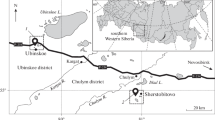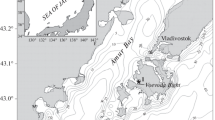Abstract
Belonging to a specific geochemical region determines the qualitative conditions for the formation of the biogenic and abiogenic properties of peat deposits of swamps. The article provides the analysis of the microbiological and enzymatic activity of different genesis peat deposits in Western Siberia and the Gorny Altai region and their influence on the hydrochemical composition of swamp waters. Most of the chemical elements in the swamp water of the Western Siberia are characterized by elevated concentrations compared to the swamps of the Gorny Altai region. However, the swamp waters of the Gorny Altai region have a predominant content of humic acids in comparison with fulvic acids, unlike the composition of swamp waters of Western Siberia. It was revealed that the redox conditions of the 1-m-thick layer of the peat deposit are of great importance, in which the hydrochemical composition of the swamp waters with individual features in each type of phytocenosis is formed on the basis of biochemical processes during the vegetative season. The maximum concentration of almost all components is observed on the margin of the swamp as a result of migration of substances in this direction from autonomous swamp landscapes. The results of studies of the biochemical activity of the 1-m-thick layer of the peat deposits of different swamps according to the genesis indicate that the peat deposits of the mesotrophic and eutrophic types are characterized by the greatest biochemical activity. On the landscape profile of geochemically linked swamps, a high overall biochemical activity is noted in the peat deposit of autonomous position. It is concluded that the migratory streams from the territory of Western Siberia, which is distinguished by a large swamping and an active manifestation of the peat formation process, influence the formation of the biogenic and abiogenic composition of river waters. The performed studies have shown that it is necessary to take into account the hierarchy and conjugation of landscapes of the river basin and the organic component of swamp waters.
Access this chapter
Tax calculation will be finalised at checkout
Purchases are for personal use only
Similar content being viewed by others
References
Baird AJ (1995) Hydrological investigations of soil water and groundwater processes in wetlands. In: Hughes JMR, Heathwaite AL (eds) Hydrology and hydrochemistry of British wetlands. Wiley, Chichester
Bakhnov VK (1986) Biogeochemical aspects of paludification process. Nauka, Novosibirsk (in Russian)
Bazin ET, Kopenkin VD, Kosov VI (1992) Technical analysis of peat. Nedra, Moscow (in Russian)
Blodau C, Roehm CL, Moor TR (2002) Iron, sulfur and dissolved carbon dynamics in a northern peatland. Arch Hydrobiol 154(4):561–583
Glazovskaya MA (1983) Foundations of classification of natural ecosystems by sustainability to man-caused impact and prediction of landscape and geochemical regioning. Sustainability of geoecosystems. Nauka, Moscow (in Russsian)
Ilina SM, Drozdova OYu, Lapitskiy SA, Alekhin YV, Demin VV, Zavgorodnyaya Yu, Shirokova LS, Viers J, Pokrovsky OS (2014) Size fractionation and optical properties of dissolved organicmatter in continuum soil solution-,jg-river and terminal lake of a boreal watershed. Org Geochem 66:14–24
Inisheva LI, Inishev NG (2001) Elements of water balance and hydrochemical characteristics of oligotrophic bogs in the South taiga subzone of Western Siberia. Water Resour Manage 28(4):371–377. https://doi.org/10.1023/a:1010433319474
Inisheva LI, Szajdak LV, Sergeeva MA(2016) Dynamics of biochemical processes and redox conditions in geochemically linked landscapes of oligotrophic bogs. Eurasian Soil Sci 49(4):466–474. https://doi.org/10.1134/s1064229316040050
Ivanov VV (1994) Ecological geochemistry of elements B, vol 2. Nauka, Moscow (in Russsian)
Karyagina LA, Mikhaylouskaya NA (1986) The value of polyphenoloxidase and peroxidase activity in peat. In: Proceedings of the National Academy of Sciences of Belarus, vol 2, pp 40–41. Agrarian Sciences Series (in Belarusian)
Khoroshavin VY, Efimenko MG (2015) Factor analysis of conditions of formation of surface waters of the Northern taiga of Western Siberia. In: Biogeochemistry of technogenesis and modern problems of geochemical ecology (in two volumes), vol 1, pp 230–233. Barnaul (in Russsian)
Kononova MM (1963) Soil organic matter. Its nature, properties and methods of study. USSR Academy of Sciences, Moscow (in Russsian)
Kovaleva RV (1973) Soils of the Gorno-Altai autonomous region. Nauka, Novosibirsk (in Russsian)
Kozhevin PA, Polyanskaya LM, Zvyagintsev DG (1979) Dynamics of development of different microorganisms in soil. Microbiology 48(4):490–494 (in Russsian)
Kruglov YuV, Paromenskaya LN (1966) Modification gasometrical method of determining catalase activity. Soil Sci 1:93–95 (in Russian)
Larina GV, Ivanova AA, Nah Kazantseva (2009) Group composition of organic matter of peat of the Altai Mountains and some structural characteristics of humic acids. Tomsk State Pedag Univ Bull 3(81):110–116 (in Russian)
Mirchink TG (1988) Soil mycology. Moscow state University Publ, Moscow (in Russsian)
Orlov DS (1974) Humic acids of soils. Moscow state university publishing house, Moscow (in Russsian)
Perel’man AI (1989) Geochemistry, vol 5, 2 ed. Higher School, Moscow (in Russian)
Polyanskaya LM (1996) Microbe successions in soil. Thesis of doctorate science, boiling. Moscow (in Russian)
Rakovsky VE, Pigulevskaya LV (1978) Chemistry and genesis of peat. Nedra, Moscow (in Russian)
Reznikov AA, Mulikowskaya EP, Sokolov IYu (1970) Methods of analysis of natural waters. Nedra, Moscow (in Russian)
Shotyk W, Rausch N, Nieminen TM, Ukonmaanaho L, Krachler V (2016) Isotopic composition of Pb in peat and porewaters from three contrasting ombrophic bogs in Finland: evidence of chemical diagenesis in response to acidification. Environ Sci Technol 50:9943–9951
Szajdak LW, Inisheva LI, Meisner T, Gaca W, Styla K (2011) Activities of enzymes participating in redox potential in the two depths of Tagan peatland. Tomsk State Pedag Univ Bull 8:70–77
Vernadsky VI (1960) The biosphere. In: Selected works vol 5. USSR Academy of Sciences, Moscow (in Russian)
Yamble DS, Cshnitzer M (1973) The chemistry of fulvic acid and its reactions with metalions. In: Singer PC (ed) Trace metals and metalorganic interactions in natural waters. Ann Arbor Science Publishers Inc, Ann Arbor
Zvyaginzev DG (1980) Methods of soil microbiology. Moscow state university publishing house, Moscow (in Russian)
Author information
Authors and Affiliations
Corresponding author
Editor information
Editors and Affiliations
Rights and permissions
Copyright information
© 2020 Springer Nature Switzerland AG
About this paper
Cite this paper
Inisheva, L.I., Porokhina, E.V., Golovchenko, A.V., Szajdak, L.W. (2020). Abiogenic and Biogenic Forms of Migration Compounds in Swamps of Different Genesis. In: Frank-Kamenetskaya, O., Vlasov, D., Panova, E., Lessovaia, S. (eds) Processes and Phenomena on the Boundary Between Biogenic and Abiogenic Nature. Lecture Notes in Earth System Sciences. Springer, Cham. https://doi.org/10.1007/978-3-030-21614-6_16
Download citation
DOI: https://doi.org/10.1007/978-3-030-21614-6_16
Published:
Publisher Name: Springer, Cham
Print ISBN: 978-3-030-21613-9
Online ISBN: 978-3-030-21614-6
eBook Packages: Earth and Environmental ScienceEarth and Environmental Science (R0)




